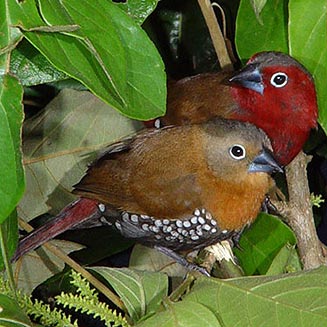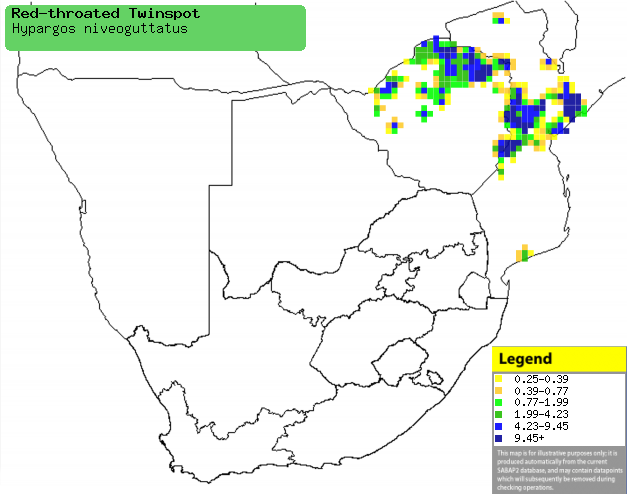|
Hypargos niveoguttatus
(Red-throated twinspot)
Rooikeelkolpensie [Afrikaans]; rode druppelastrild [Dutch];
Sénégali enflammé [French]; Rotkehl-tropfenastrild [German];
Pintadinho-de-peito-vermelho [Portuguese]
Life
> Eukaryotes >
Opisthokonta
> Metazoa (animals) >
Bilateria >
Deuterostomia > Chordata >
Craniata > Vertebrata (vertebrates) > Gnathostomata (jawed
vertebrates) > Teleostomi (teleost fish) > Osteichthyes (bony fish) > Class:
Sarcopterygii (lobe-finned
fish) > Stegocephalia (terrestrial
vertebrates) > Tetrapoda
(four-legged vertebrates) > Reptiliomorpha > Amniota >
Reptilia (reptiles) >
Romeriida > Diapsida > Archosauromorpha > Archosauria >
Dinosauria
(dinosaurs) > Saurischia > Theropoda (bipedal predatory dinosaurs) >
Coelurosauria > Maniraptora >Aves
(birds) > Order: Passeriformes
> Family: Estrildidae
 |
|
|
Red-throated twinspot female (left) and male
(right). [photo Guy Upfold ©] |
|
Distribution and habitat
Occurs from Kenya through Tanzania, Zambia and Malawi to
southern Africa. Here it is locally common in Zimbabwe and north-central
Mozambique, generally preferring edges of evergreen forest, thickets and tangled
vegetation along rivers.
|
 |
|
Distribution of Red-throated twinspot in southern Africa,
based on statistical smoothing of the records from first SA Bird Atlas
Project (©
Animal Demography unit, University of
Cape Town; smoothing by Birgit Erni and Francesca Little). Colours range
from dark blue (most common) through to yellow (least common). |
Food
It mainly eats grass seeds supplemented with small
arthropods, doing most of its foraging on patches of open ground in dense
vegetation. The following food items have been recorded
in its diet:
- Grass seeds
- Panicum (guinea grasses)
- Urochloa mosambicensis (Common urochloa)
- Tricholaena monachne (Blue-seed grass)
- Setaria incrassata (Vlei bristle grass)
- Arthropods
Breeding
- The nest is built by both sexes, consisting of an oval-shaped structure
with a short entrance tunnel, made of maiden-hair fern (Adiantum)
stems, fine rootlets, skeletonised leaves (for camouflage) and moss, lined
with feathers or dry moss. It is typically placed among tree roots or on a
low branch on a sloping bank, less than one metre above ground.
- Egg-laying season is from September-June, peaking from January-April in
Zimbabwe and from March-June in Mozambique.
- It lays 3, rarely up to 6 eggs, which are incubated by both sexes for
about 12-13 days.
- The chicks are fed by both parents, leaving the nest after about 18-23
days (recorded in captivity) and becoming fully independent about 18 days
later.
Threats
Not threatened, although deforestation in Mozambique,
overgrazing and the cage-bird trade are definitely cause for concern.
References
-
Hockey PAR, Dean WRJ and Ryan PG 2005. Roberts
- Birds of southern Africa, VIIth ed. The Trustees of the John Voelcker
Bird Book Fund, Cape Town.
|
